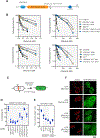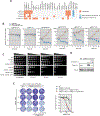A Genetic Map of the Response to DNA Damage in Human Cells
- PMID: 32649862
- PMCID: PMC7384976
- DOI: 10.1016/j.cell.2020.05.040
A Genetic Map of the Response to DNA Damage in Human Cells
Abstract
The response to DNA damage is critical for cellular homeostasis, tumor suppression, immunity, and gametogenesis. In order to provide an unbiased and global view of the DNA damage response in human cells, we undertook 31 CRISPR-Cas9 screens against 27 genotoxic agents in the retinal pigment epithelium-1 (RPE1) cell line. These screens identified 890 genes whose loss causes either sensitivity or resistance to DNA-damaging agents. Mining this dataset, we discovered that ERCC6L2 (which is mutated in a bone-marrow failure syndrome) codes for a canonical non-homologous end-joining pathway factor, that the RNA polymerase II component ELOF1 modulates the response to transcription-blocking agents, and that the cytotoxicity of the G-quadruplex ligand pyridostatin involves trapping topoisomerase II on DNA. This map of the DNA damage response provides a rich resource to study this fundamental cellular system and has implications for the development and use of genotoxic agents in cancer therapy.
Keywords: CRISPR; DNA damage; DNA repair; DNA-damaging agents; cancer therapeutics; functional genomics; genome stability; mechanism-of-action.
Copyright © 2020 Elsevier Inc. All rights reserved.
Conflict of interest statement
Declaration of Interests Michal Zimmermann is an employee and shareholder of Repare Therapeutics. Daniel Durocher is a founder of Repare Therapeutics and a member of its scientific advisory board.
Figures






Comment in
-
A genetic roadmap to the response to genotoxic agents in human cells.Fac Rev. 2022 Nov 21;11:35. doi: 10.12703/r-01-0000019. eCollection 2022. Fac Rev. 2022. PMID: 36532708 Free PMC article.
References
Publication types
MeSH terms
Substances
Grants and funding
LinkOut - more resources
Full Text Sources
Other Literature Sources
Molecular Biology Databases
Research Materials

